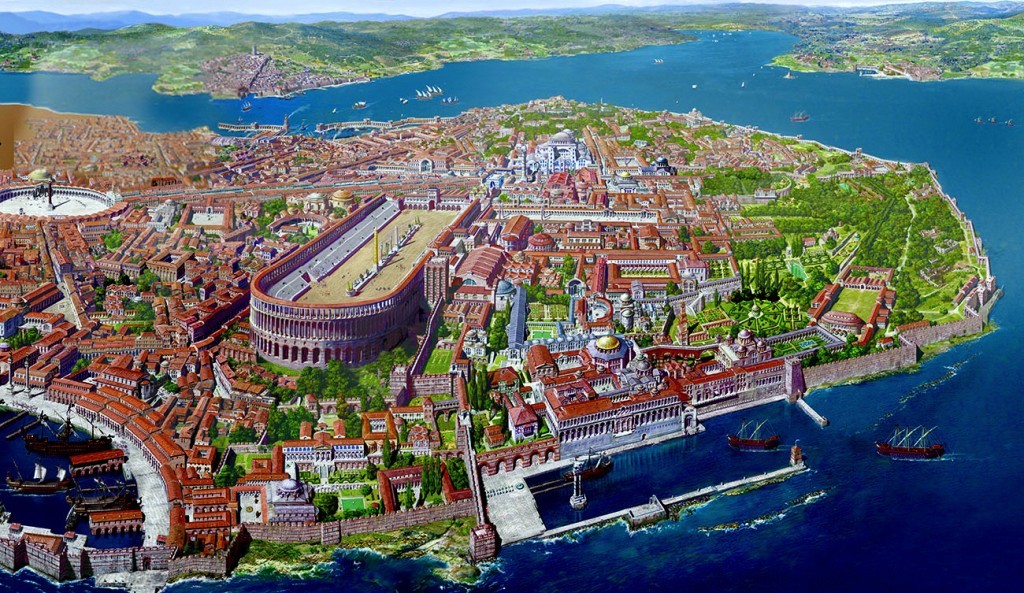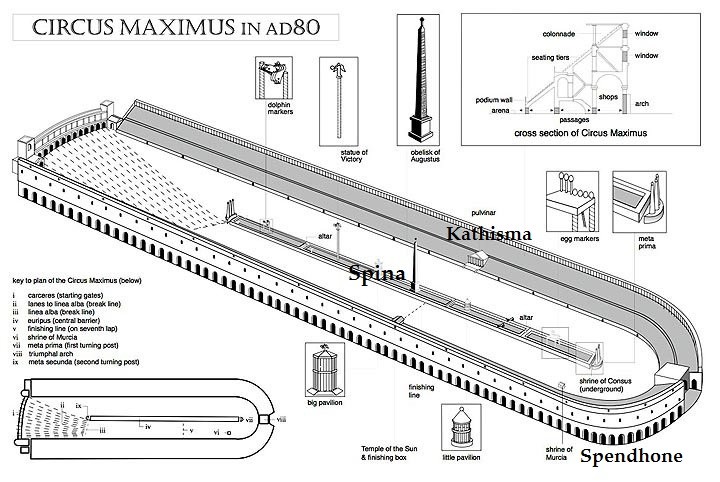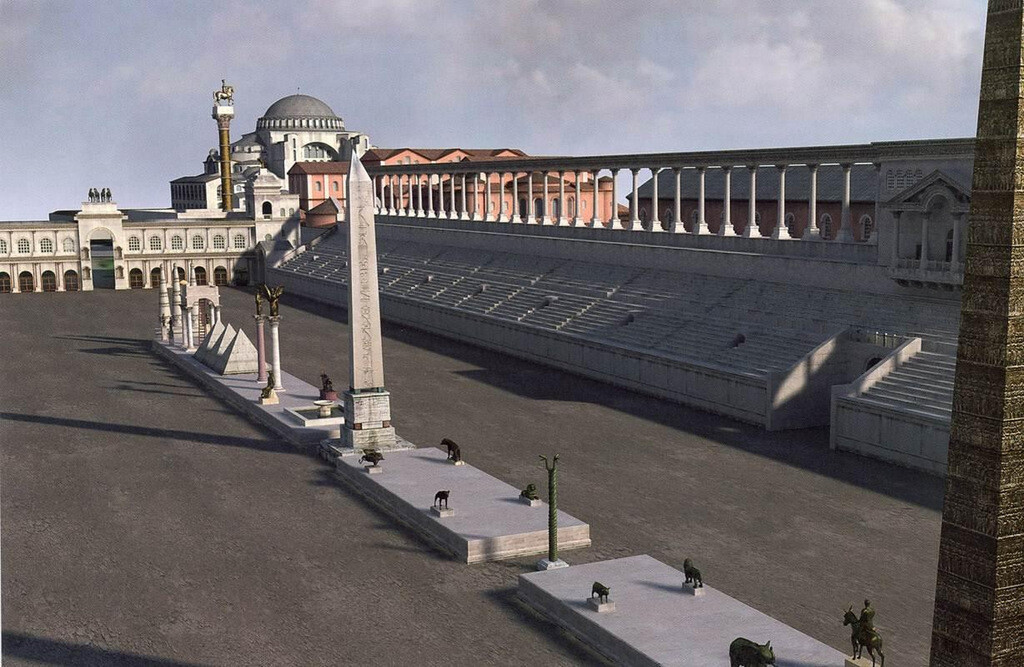The Hippodrome of Constantinople (today Sultanahmet Square) was the center of social life in the Byzantine Empire for centuries. The Hippodrome, where relentless chariot races were held, was also the scene of many rebellions and massacres.
Today, the Hippodrome is located in Sultanahmet, in the heart of Istanbul’s Old City. Focusing on Hagia Sophia and Blue Mosque, visitors can overlook the Hippodrome. However, two of the oldest historical monuments of Istanbul, such as the Obelisk of Theodosius and the Serpent Column, are located here.
In this article you can find information about the history and architecture of the Hippodrome of Constantinople. In addition, interesting facts about the Hippodrome (aka Sultanahmet Square) are noted.
Foundation of Constantinople
In 330 AD, the Emperor Constantine moved the capital of Roman Empire from Rome to Byzantium. After six years of work by the imperial architects and engineers, the small Greek town Byzantium was rebuilt and turned into an imperial capital.
The most important buildings in the newly built city were the Great Palace, the Church of the Holy Apostles, the Forum of Constantine and the Roman Hippodrome. The Foundation of Constantinople would allow Roman culture to survive in the East for another 1100 years.
In the picture above, we see that Hippodrome was the most prominent structure of old Istanbul. Immediately to the right is the Great Palace, where Emperors lived, behind Hagia Sophia, and to the left is Forum Constantine, the city’s main square.
Hippodrome of Constantinople Architecture
In the city of Byzantium there was a small Hippodrome built by the Roman emperor Septimius Severus, who conquered the city in the late 2nd century. When Constantine declared the city as the new capital, it was decided to make a more magnificent one. The famous Circus Maximus in Rome was taken as the model for this new hippodrome.
The architecture of the Hippodrome of Constantinople was in the form of a U-shaped race track. Curval Tribune of the Hippodrome was called as “Sphendone” and Emperor’s lodge was called as “Kathisma”. Central axis with monuments and columns was named “Spina”.
Emperor Constantine wanted to decorate his city in the most beautiful way. For this purpose, important monuments from the ancient cities of the Roman Empire were brought to decorate the Hippodrome.
Most of the works in the Hippodrome have not survived. However, the Egyptian Obelisk, the Serpent Column, and the Walled Obelisk are still in place. Some of the works that had adorned the Hippodrome were stolen during the Sack of Constantinople (during the IV Crusade), while others were destroyed by earthquakes and fires.
Hippodrome of Constantinople History & Facts
The Hippodrome of Constantinople remained the most important entertainment center of Byzantium throughout its history. Constantinople was one of the largest cities of the Middle Ages, with a population of around 500,000. The ancient chariots drawn by four horses were racing to the death in the Hippodrome.
Hippodrome races, the most important sports competition of that period, were also watched by the city elites including the emperor. The Emperor had a lodge (Kathisma) that he could reach through the palace. From here he would watch the races and also listen to the voice of the public.
The chariot races were more than a sporting event, they had also a political meaning. The Hippodrome, the only place where the people and the emperor came together, was the place where discontent in society came to light.
Blues and Greens
There were two teams in the race track called Blues and Greens. However, the supporters of these teams were almost hostile to each other. The Blues were mostly favored by the wealthy community, while the Greens were supported by farmers, merchants and workers.
They also belonged to two different religious denominations, Orthodox and Monophysite, as well as socially different levels. This division was fueling hostility. A small spark was enough for the great uprisings to emerge.
There were moments when emperors could hardly save their lives because of the riots that started from the Hippodrome. Two of these rebellions emerged during the reign of Anastasius and Justinian, two of the greatest rulers of the Byzantine Empire.
The Nika Revolt, the most important rebellion in the history of Constantinople, began here and spread throughout the city. This riot was suppressed by Justinian’s famous general, Flavius Belisarius. The massacre, in which 30,000 people were put to the sword, cast a shadow over the reputation of the Hippodrome.
Hippodrome in the Ottoman Period
The Hippodrome was a public square used for festivals and banquets during the Ottoman period. The biggest festivities in the Hippodrome were when the sisters or daughters of the sultans got married. In addition, the circumcision of the princes was also a reason for celebration.
The execution of deposed emperors in the Hippodrome took place many times during the Byzantine period. In Ottoman history, some statesmen were executed by the rebels in the Hippodrome. On the other hand, when the rebellions were suppressed, the rebels were also hanged here.
You can see how the Hippodrome looked during the Ottoman period from the picture above. From left: Egyptian Obelisk, Serpent Column, Walled Obelisk. Picture taken from a history book written by historian Stefanos Yerasimos.
The Hippodrome in Istanbul (Sultanahmet Square)
The Hippodrome is located at the most touristic spot in Istanbul today. Surrounded by Hagia Sophia, the Blue Mosque and the Turkish and Islamic Arts Museum, the Hippodrome is also known as Sultanahmet Square.
Hippodrome in Istanbul is now an open-air museum and does not have an entrance fee. The three historical monuments you will see while touring the Hippodrome are Obelisk of Theodosius, Serpent Column and Walled Obelisk, respectively.
In addition to these, there is another work called the German Fountain, which was added to the Hippodrome Square during the Ottoman period. You can read the story of each in the lines below.
1. Obelisk of Theodosius
The obelisks in Ancient Egypt were monuments erected in honor of the pharaohs. The Obelisk of Theodosius, adorning the Hippodrome, was originally erected by Thutmose III in 1500 BC. Its main location was the Karnak Temple in Egypt. Obelisk was one of two monumental columns erected to symbolize the victories of Thutmose III, one of the warrior emperors of Ancient Egypt.
The obelisk was a monolithic granite column about 35 meters high. Next to it was another granite column of the same size. Twin obelisks were placed at the entrance of the Karnak Temple. On the obelisks, the lands of Pharaoh stretching from Egypt to Mesopotamia were described.
It was a great project to bring the obelisk from Egypt to Constantinople. One of the largest ships in the Roman navy had to be commissioned. But somehow it would not reached its new place for 60 years. Obelisk remained in the Port of Alexandria for years, and only half a century later it was brought to Constantinople.
The ship, which brought the obelisk, finally reached Constantinople in 390, during the reign of Emperor Theodosius. Proclus, the governor of Constantinople at that time, erected the column to the Hippodrome in honor of the emperor. That is why Obelisk is identified with Theodosius the Great.
Marble Base of the Obelisk of Theodisius
Of course, the transportation of the 35 meter long column from Egypt to Istanbul was not easy. The breaking of the column occurred in Alexandria according to some historians and in Constantinople according to others. As a result, a 20-meter top remained from the 35-meter column.
It was necessary to raise the Obelisk of Theodosius, which was short compared to other columns in the hippodrome. For this purpose, a marble base decorated with reliefs prepared by the Romans was placed under it. In these reliefs, Emperor Theodosius was depicted watching the races with his sons Arcadius and Honorius.
By the way, it is worth noting that Theodosius I was the last ruler of the unified Roman Empire. His sons, Arcadius and Honorius, became the rulers of the Eastern and Western Roman empires when their father died.
2. Serpent Column
The Serpent Column was built to celebrate the victory of the 31 Greek city-states united against the Persian invasion. The most important feature of the column is that it was made of shields of Persian soldiers who were defeated.
The Greco-Persian wars were one of the most important events of antiquity. This monument, symbolizing victory, had been erected in the Temple of Apollo in Delphi, the holiest place in Ancient Greece. According to some sources, there was a golden cauldron on the snakes’ heads when they were brought to Constantinople.
Unfortunately, the snake heads, which were known to be in place until the late period of the Ottoman Empire, are no longer there. According to some sources, it was broken in the earthquake, while some sources report that it was the victim of vandalism. The jaw part of one of the snakes is exhibited in the Istanbul Archaeological Museum.
3. Walled Obelisk
The third important structure is the Walled Obelisk (Column of Constantine) whose construction date is unknown. The Walled Obelisk was rebuilt in the 10th century and was named after the Emperor Constantine VII.
The column, which was surrounded by bronze plates in its first period, was looted during the Sack of Constantinople (Fourth Crusade) in 1204. During the Sack of Constantinople, the treasures of Constantinople were stolen and taken to Italy.
Among these were 4 bronze horse statues adorning the monumental entrance of the Hippodrome. These horses are now in St Mark’s Basilica in Venice. The stolen columns of the Church of St. Polyeuktos are also in the same place. On the other hand, the relics of St John Chrysostom were returned to Istanbul in 2004.
In the image above you can see the Walled Obelisk on the far right. The Obelisk, decorated with bronze plates shining like gold. At the back of the painting, horse statues at the gate of the Hippodrome can be seen. On the long column in Augustaion Square, you can see the Statue of Justinian.
You can find the reconstruction pictures of the Hippodrome and other historical buildings of Constantinople on the Byzantium1200 site. The images on this site show the most magnificent city of the Middle Ages, Constantinople, before it was sacked in 1204.
4. German Fountain
While walking around the Hippodrome, you will see a public fountain that was added to the square in the 20th century. This work, called the German Fountain, was gifted to the city by Kaiser Wilhelm II.
Kaiser Wilhelm II had visited Istanbul several times before the First World War. Allied Ottomans and Germans were making some gestures to each other. The German Emperor built this magnificent fountain in Germany and sent to Istanbul in parts by trains.
German Fountain was the symbol of friendship between the Ottoman Sultan Abdulhamid II and German Emperor Kaiser Wilhelm II. There are magnificent mosaic decorations under the dome of the still active fountain. These mosaics, which also refer to the city’s Eastern Roman past, are in golden colour.
Conclusion
As a private tour guide in Istanbul, the Hippodrome is one of my favorite historical places. I like to start my tours in the Old City from here and present my guests with a summary of the history of Istanbul.
There is a lot of interesting facts to convey about the former Hippodrome of Constantinople. My guests get excited when I tell these beautiful stories alongside the oldest historical monuments of Istanbul.
Unfortunately, many of those who visit Istanbul do not know about the existence of the Hippodrome. However, this is one of the places in Istanbul where you will need a tour guide the most.
Here, it is possible to talk about the Ancient Greek, Roman and Byzantine periods of Istanbul in detail and to revive these historical artifacts in the eyes of the audience. This is often the distinguishing part of my private tours.
Written by Serhat Engul




Great pictures of Istanbul!
Dear Serhat Engül,
can I use your picture of the hippodrom for a book about “Mathematics in Byzantion”?
Thank you in advance!
Dear Dietmar Herrmann, thank you for your feedback on the article. Unfortunately, these images are from books, public digital libraries and stock photography sites. For this reason, I cannot give you permission to use any of them in print.